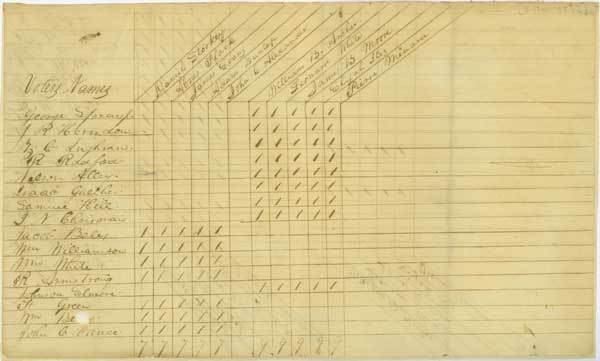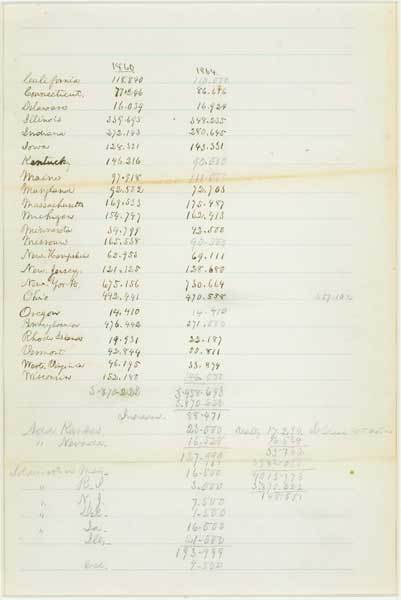Two documents in the Abraham Lincoln Presidential Library and Museum’s collection give us unique glimpses of Lincoln at two very different stages of his career. They also show the American democratic system at work in two very different moments.
 Election Returns for the New Salem Precinct in Sangamon County, Illinois, November 5, 1832, written by Abraham Lincoln (Abraham Lincoln Presidential Library and Museum).
Election Returns for the New Salem Precinct in Sangamon County, Illinois, November 5, 1832, written by Abraham Lincoln (Abraham Lincoln Presidential Library and Museum).
One of the lesser-known jobs Lincoln tried during his time in New Salem was election clerk. In the first document, we see Lincoln recording his neighbors’ 1832 Electoral College votes—a presidential election between incumbent Andrew Jackson and Lincoln’s political hero, Henry Clay. At the time, citizens voted “viva voce,” or “by voice,” which means they would have approached Lincoln, declared their vote, and then he would have written it down.
Jackson won Illinois, including Sangamon County where Clay did slightly better than most places in the state. Lincoln was up for election that year too — his first — but also lost. Clay famously never won the presidency, despite running numerous times. However, his Whig Party would count Lincoln among its members and Lincoln would never again lose an election for state office, serving in the Illinois House of Representative from 1834 to 1842.
Although Jackson and Clay were intense political rivals, they were also both slaveholders. By 1860, the debate over slavery’s potential expansion into America’s western territories had destroyed Clay’s Whig Party and carved deep cracks in Jackson’s Democratic Party. A new coalition of former Whigs, disillusioned Democrats, anti-slavery advocates, and others had coalesced into the Republican Party, and Lincoln became the its first member to win the presidency. It was a meteoric political event that persuaded the South to try to leave the Union and form its own slaveholding republic — sparking the Civil War.
 Tabulations and Comparison of Election Returns—1860 and 1864, written by Abraham Lincoln (Abraham Lincoln Presidential Library and Museum).
Tabulations and Comparison of Election Returns—1860 and 1864, written by Abraham Lincoln (Abraham Lincoln Presidential Library and Museum).
This second document finds Lincoln once again putting his pen to paper to record election results, thirty-two years after he earned a little money counting votes in New Salem. He had just won his second term as president. Using letters received from governors and Republican allies, Lincoln compared his margin of victory in 1860 to 1864. It is, in effect, Lincoln checking the nation’s pulse after one term of his presidency and almost four years of civil war.
Yet Lincoln was more than just curious. On December 6, he sent what would be his final “Annual Message to Congress.” In it, he argued this election data proved “the purpose of the people, within the loyal States, to maintain the integrity of the Union, was never more firm, nor more nearly unanimous, than now.” Furthermore, he argued that the support he received proved voters were ready to approve a new constitutional amendment making slavery illegal—what would become the 13th Amendment.
These two documents show American democracy playing out in real time. They remind us not only of Lincoln’s remarkable rise, but how the sometimes-messy democratic process can bring about real change, rendering the America of 1864 a very different place from what it was when Lincoln first recorded an election in 1832.
Both these documents are scheduled to be on display in the “Political Life” cases at the Abraham Lincoln Presidential Library and Museum in the coming months. You can learn more about Lincoln’s 1832 election returns at our Papers of Abraham Lincoln project here.
Christian McWhirter
Lincoln Historian